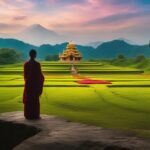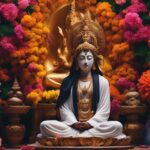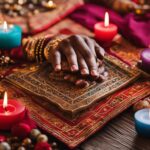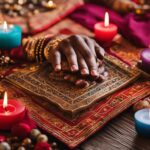The early Bhakti tradition in Hinduism is characterized by the composition of poems of prayer by poet-saints known as Alvars and Nayanars. These heartfelt poems expressed intense emotional attachment and love for their chosen deities. They played a significant role in religious reforms and became an integral part of temple rituals and worship.
Key Takeaways:
- The early Bhakti tradition in Hinduism involved the composition of poems of prayer by poet-saints known as Alvars and Nayanars.
- These poems expressed intense emotional attachment and love for the chosen deities.
- The poems played a significant role in religious reforms and became an integral part of temple rituals and worship.
- The Bhakti tradition challenged societal norms and welcomed people from all genders and castes as devotees.
- The movement spread to North India, influenced by Muslim ideas of surrender to God, and featured prominent poet-saints such as Kabir.
Origins of Bhakti Tradition
The Bhakti tradition in Hinduism traces its origins to South India during the 7th to 10th centuries. This period marked the emergence of a powerful devotional movement that revolutionized religious practices and challenged societal norms.
The movement was characterized by the composition of devotional poems by poet-saints known as Alvars, who were devotees of Lord Vishnu, and Nayanars, who worshiped Lord Shiva. These poet-saints traveled from place to place, singing hymns in Tamil, a regional language, in praise of their chosen deities.
The poems composed by the Alvars and Nayanars expressed intense emotional attachment and unwavering love for the gods. They explored the profound relationship between the devotee and the divine, portraying themes of devotion, surrender, and divine grace.
The Alvars and Nayanars initiated a movement that went beyond religious rituals and Brahmanical authority. They protested against the caste system and challenged the notion that only the Brahmanas had exclusive access to spiritual knowledge. Through their devotional poems, they claimed their traditions to be as important as the Vedas, empowering people from all genders and castes to become devotees of the divine.
The devotional poems of the Alvars and Nayanars became integral to temple rituals and the worship of their images. The bhakti movement brought about significant religious reforms and broadened the horizons of devotion, welcoming worshippers from diverse backgrounds.
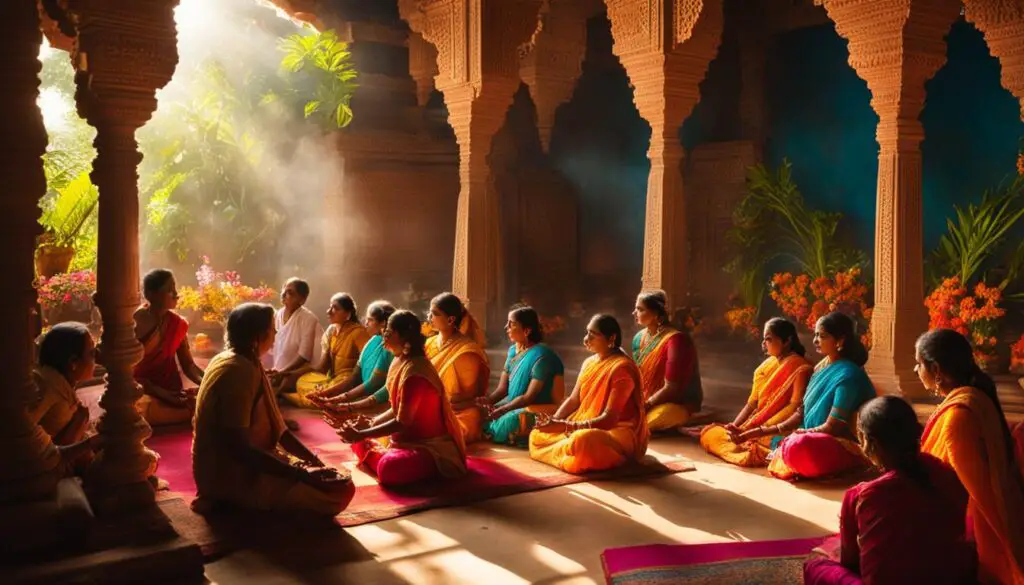
Themes in Bhakti Poetry
Bhakti poetry in Hinduism delves into the profound themes of love, devotion, and the intricate relationship between the devotee and the deity. These poems serve as an expression of intense emotions, capturing the devotee’s longing, surrender, and unwavering commitment to their chosen god or goddess.
Love is a central theme in Bhakti poetry, with the poems often portraying the divine as an absent lover or a compassionate ruler. The devotees express their deep affection, yearning for union, and longing for the divine presence in their lives.
Deity-centered worship is another prevalent theme in Bhakti poetry. The poems revolve around the worship of specific deities, such as Vishnu, Shiva, or various forms of the Goddess. The devotees engage in rituals, hymns, and offerings to honor and connect with their chosen deity.
Tamil devotional poetry, originating from South India, holds a significant place in the Bhakti tradition. These poems, composed in the regional language of Tamil, are evocative expressions of devotion and explore the complexities of the devotee’s relationship with the divine.
The fusion of secular and religious traditions in Bhakti poetry is seen in its inspiration from the Tamil poetic tradition and the royal courtly traditions of the time.
The influence of Sufi ideas and practices on Bhakti poetry is notable, as mystical elements are incorporated into the poems. The mystical aspects of Sufism, emphasizing intense devotion and love for God, find resonance in the emotional depth of Bhakti poetry.
Bhakti poetry played a pivotal role in social reform during its time. These poems questioned the authority of the Brahmanas and challenged the rigid caste system prevalent in society. The Bhakti movement welcomed devotees from all genders and castes, providing a platform for marginalized communities to voice their devotion and seek spiritual solace.
The enduring legacy of Bhakti poetry continues to inspire and resonate with devotees today. Its profound themes of love, devotion, and the intimate relationship between the devotee and the deity serve as a testament to the power of unconditional devotion and surrender on the path to spiritual enlightenment.
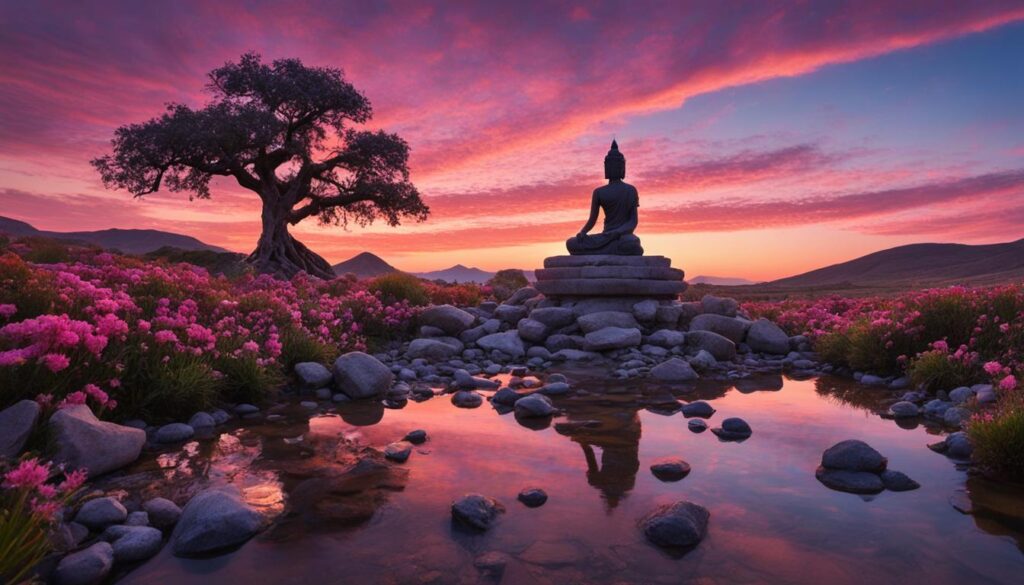
| Theme | Description |
|---|---|
| Love and Devotion | Intense emotions expressed through devotion and longing for the divine. |
| Relationship between Devotee and Deity | Exploration of the intricate connection between the devotee and the chosen god or goddess. |
| Deity-Centered Worship | Rituals, hymns, and offerings dedicated to honoring the chosen deity. |
| Tamil Devotional Poetry | Rich tradition of Bhakti poems composed in the regional language of Tamil. |
| Sufi Influence | Inclusion of mystical elements and inspiration from Sufi ideas and practices. |
| Social Reform | Challenges to the caste system and advocacy for inclusivity in devotion. |
Worship and Rituals in the Bhakti Tradition
In the Bhakti tradition, worship is an essential component of expressing devotion to the chosen deity. Through various rituals and practices, devotees engage in acts of reverence and seek spiritual connection. These rituals, deeply rooted in the bhakti movement, encompass a range of customs and traditions that reflect the devotee’s love and devotion.
One of the primary forms of worship in the Bhakti tradition is the recitation of God’s name. Devotees chant the sacred names of their chosen deities, infusing their minds and hearts with devotion. The repetitive utterance of the divine names is believed to bring spiritual purification and facilitate a deep connection with the divine presence.
Singing hymns is another integral aspect of worship in the Bhakti tradition. Devotees express their devotion through melodious praises and devotional songs dedicated to their chosen deities. These hymns, filled with love and adoration, evoke a sense of spiritual ecstasy and inspire a profound connection with the divine.
Offerings play a significant role in Bhakti worship. Devotees present food, fruit, flowers, and other sacred items as offerings to their deities. This act of offering symbolizes the devotee’s gratitude, love, and surrender to the divine. It is believed that through these offerings, devotees establish a deeper spiritual connection and receive blessings from the divine.
Darshan, meaning “divine sight,” is an essential component of temple worship in the Bhakti tradition. Devotees seek to have darshan of the deity, whereby they not only see the divine image but also receive the divine gaze upon them. Through this act of darshan, devotees experience a direct connection with the divine, deepening their devotion and spiritual experience.
Temple worship is a central practice in the Bhakti tradition. Devotees visit temples to offer their prayers, engage in rituals, and participate in community worship. Temples serve as sacred spaces where devotees can come together to express their devotion and experience a sense of spiritual unity.
Worship in the Bhakti tradition is not merely a set of rituals; it is an act of love, surrender, and devotion. Through recitation of God’s name, singing hymns, making offerings, and seeking darshan, devotees establish a profound connection with the divine and experience the transformative power of devotion.
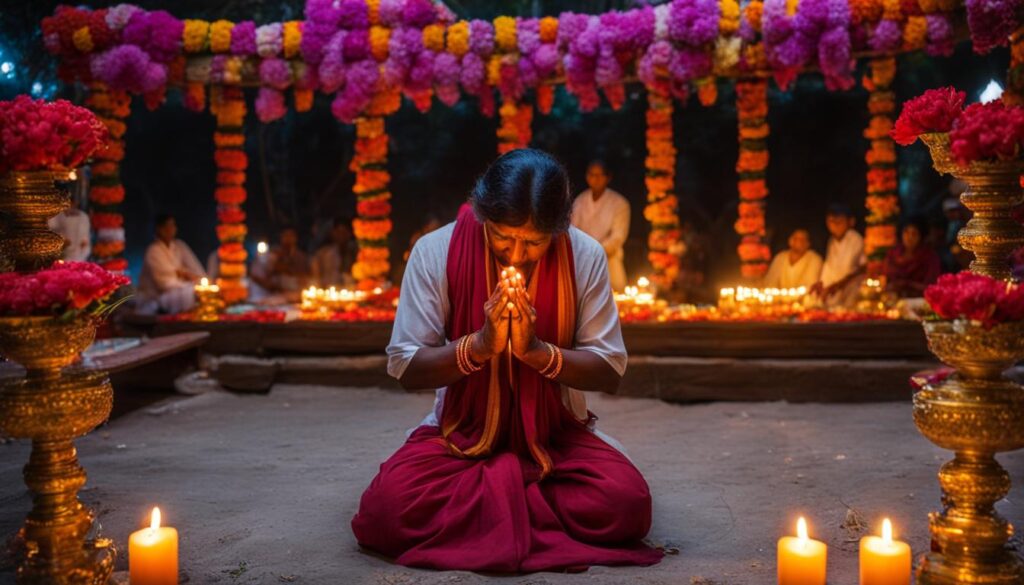
In the Bhakti tradition, worship is a deeply meaningful and powerful practice that brings devotees closer to their chosen deities. It is a way to express love, devotion, and gratitude while seeking spiritual blessings and the grace of the divine. Through the rituals and customs of worship, devotees experience a profound sense of connection and find solace in the embrace of their chosen deity.
Major Devotional Movements and Poets
The Bhakti movement in Hinduism gave birth to significant devotional movements and produced renowned poets who left an indelible mark on the tradition. Explore the lives and contributions of these prominent figures:
Ramanuja
Ramanuja, a philosopher and theologian, was a key figure in the Bhakti tradition. He emphasized the doctrine of surrender to God and the concept of grace, highlighting the importance of complete devotion to attain spiritual liberation.
Mira Bai
Mira Bai, a princess turned saint, captured hearts with her passionate poems expressing love and devotion to Lord Krishna. Her verses serve as a testament to the power of divine love and the transformative nature of bhakti.
Chaitanya
Chaitanya, a saint from the 15th century, popularized kirtan, a form of devotional singing, and emphasized the significance of love and devotion in achieving spiritual union with the divine. His teachings continue to inspire and uplift devotees.
Tulsidas
Tulsidas, known for his notable retelling of the Ramayana in Hindi, focused on themes of loyalty and friendship in the relationship between Lord Rama and his devotees. His works played a significant role in popularizing the Ramayana and spreading devotion to Lord Rama.
Ravidas
Ravidas, a Dalit poet-saint, challenged social hierarchies through his devotional poetry, advocating for equality and social justice. His verses embody the spirit of inclusivity and serve as a powerful voice for marginalized communities.
These prominent poets and their respective movements contributed to the diverse and rich tapestry of the Bhakti tradition, leaving a lasting impact on the spiritual and cultural landscape of India.
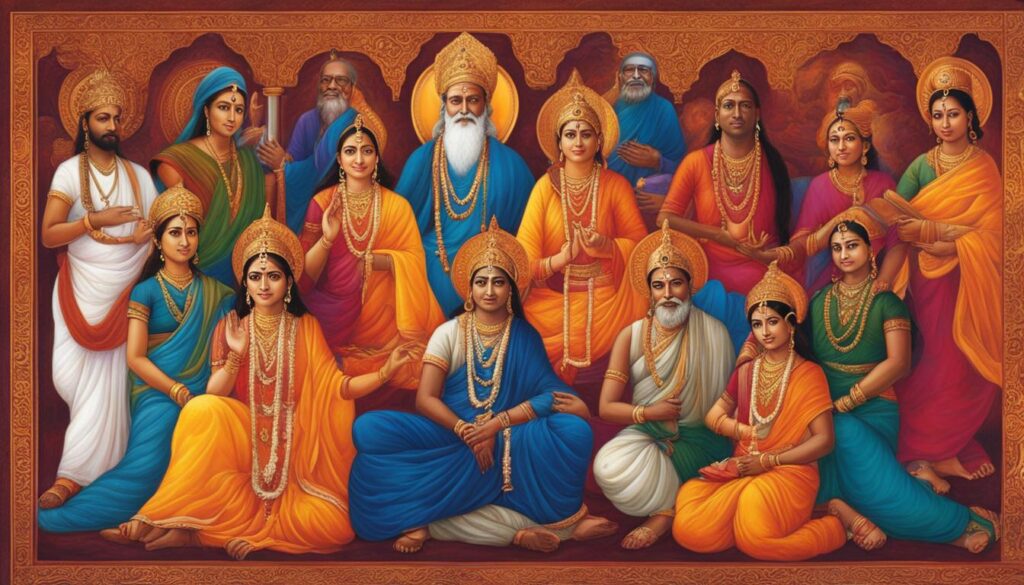
Bhakti Traditions and Deities
The Bhakti tradition encompasses various devotional practices and worship of different deities, creating diverse bhakti traditions. These traditions center around the devotion to specific gods and goddesses, with each tradition having its own unique rituals, hymns, and festivals associated with the chosen deity. Let’s explore the three major bhakti traditions:
Vishnu-bhakti: Devotion to Lord Vishnu
Vishnu-bhakti focuses on the worship of Lord Vishnu, known as the preserver and protector of the universe. This tradition includes devotion to Vishnu’s avatars, such as Lord Krishna and Lord Rama. Devotees express their love and reverence through prayers, chanting of mantras, and engaging in various acts of devotion.
Shiva-bhakti: Devotion to Lord Shiva
Shiva-bhakti centers around Lord Shiva, the destroyer and transformer in Hinduism. This tradition involves deep devotion to Lord Shiva and his manifestations, such as Nataraja (the cosmic dancer) and Ardhanarishvara (the divine androgynous form). Devotees engage in rituals, meditation, and the chanting of sacred hymns to express their devotion to the powerful deity.
Devi-bhakti: Devotion to the Goddess
Devi-bhakti is devoted to various forms of the Goddess, also known as Devi or Shakti. This tradition reveres the divine feminine energy and expressions of the goddesses such as Durga, Kali, Lakshmi, and Saraswati. Devotees worship the goddess through prayers, recitation of hymns, and participation in vibrant festivities celebrating her power and grace.
The devotion to deities in the Bhakti movement varies across regions and is often influenced by local customs and practices. Regional variations contribute to the diversity of the Bhakti movement, enriching the tapestry of devotion in Hinduism.
| Bhakti Tradition | Main Deities | Unique Rituals and Practices |
|---|---|---|
| Vishnu-bhakti | Lord Vishnu, Krishna, Rama | Recitation of Vishnu’s names, singing of bhajans and kirtans, Krishna Leela performances |
| Shiva-bhakti | Lord Shiva, Nataraja, Ardhanarishvara | Offerings of water and bilva leaves, recitation of Shiva mantras, performance of Rudra Abhishekam |
| Devi-bhakti | Goddesses Durga, Kali, Lakshmi, Saraswati | Creation of elaborate altars, recitation of Durga Saptashati, participation in Navaratri celebrations |
Bhakti and Social Reform
Social reform was an integral aspect of the Bhakti movement. The poet-saints of the movement challenged the caste system and the dominance of Brahmanas. They advocated for the inclusion of marginalized communities, such as women and Shudras, who were traditionally excluded from Vedic learning and temple rituals.
“Our traditions are as important as the Vedas,” proclaimed the Alvars and Nayanars, posing a challenge to patriarchal norms and societal hierarchies.
The poetry of the Bhakti movement gave voice to the marginalized and questioned the oppressive caste system. It sought to create a more inclusive and egalitarian society, where love and devotion to the divine transcended societal barriers and prejudices.
The Bhakti movement paved the way for social transformation, challenging the injustices of the caste system and welcoming individuals from all backgrounds as devotees of the divine. It championed the rights of marginalized communities, stood against patriarchal norms, and promoted equality and inclusion.
Key Points:
- Challenge to the caste system through the advocacy of inclusivity and equality
- Inclusion of marginalized communities, including women and Shudras
- Questioning patriarchal norms and societal hierarchies
- Promotion of an egalitarian society where love and devotion connected all individuals
In the words of the poet-saints, the Bhakti movement aimed to dismantle the barriers that divided society and foster a more compassionate, inclusive, and just world.
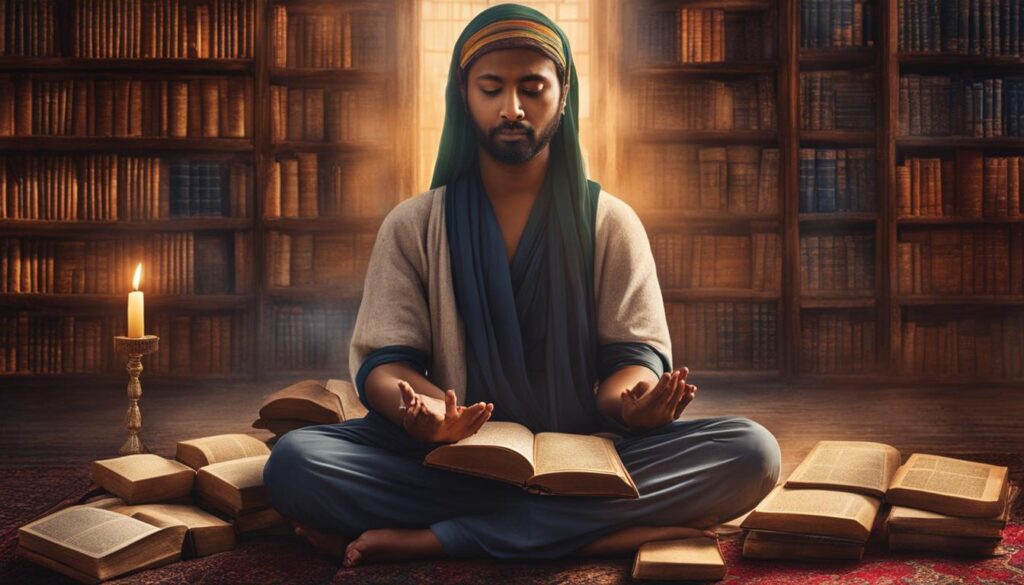
Bhakti Movement in North India
The Bhakti movement, which originated in South India, eventually spread to North India, where it encountered diverse religious traditions and influences. The movement found fertile ground in North India due to the presence of different Rajput states, providing an environment for its growth and development.
In North India, the Bhakti movement was also shaped by the influence of Muslim ideas, particularly the concept of surrender to God. This intermingling of Muslim and Hindu ideologies resulted in a unique fusion of beliefs, practices, and customs within the Bhakti tradition.
The religious leaders of the Bhakti movement in North India challenged orthodox Brahmanical frameworks and integrated local customs and traditions into their devotional practices. This integration not only allowed for a diverse expression of religious devotion but also fostered a sense of inclusivity and acceptance within the movement. Devotees from different backgrounds and social statuses found a place within the Bhakti tradition.
The establishment of the Delhi Sultanate in the 13th century had a profound impact on the cultural and religious landscape of North India. The interaction between the rulers of the Delhi Sultanate and local religious leaders further shaped the Bhakti movement, resulting in the emergence of unique regional variations and practices.
The Bhakti movement gained support from regional rulers who recognized its significance and contributed to its growth. For example, the Chola rulers in South India constructed temples dedicated to Vishnu and Shiva, further promoting the worship of these deities and spreading the influence of the Bhakti movement in North India.
Notable Leaders of the Bhakti Movement in North India
| Religious Leader | Contributions |
|---|---|
| Kabir | A poet-saint who blended elements of Sufism and Hinduism in his devotional poetry, emphasizing the unity of all religions. |
| Tulsidas | Renowned for his composition of the epic Ramayana in Hindi, highlighting the devotion and loyalty of Lord Rama’s followers. |
| Mira Bai | A devotee of Lord Krishna who expressed her unwavering love and devotion through soul-stirring poetry and songs. |
| Surdas | Known for his heartfelt compositions dedicated to Lord Krishna, emphasizing the power of divine love. |
The Bhakti movement in North India, influenced by diverse religious traditions and the changing socio-political landscape, played a significant role in shaping the religious fabric of the region. It celebrated the power of devotion, inclusivity, and the integration of local customs, leaving a lasting impact on the cultural and spiritual heritage of North India.
Sufi Influence on the Bhakti Movement
The Bhakti movement in India was deeply influenced by the mystical ideas and practices of Sufism, a branch of Islam that emphasized intense devotion and love for God. This infusion of Sufi influence brought new dimensions to the worship of the divine, enriching the emotional and spiritual depth of Bhakti poetry.
In Bhakti poetry, we see the inclusion of mystical elements that resonate with Sufi ideals. The poems often express a longing for union with the divine, depicting the devotee’s intense yearning for a closer relationship with God. The exploration of the devotee’s connection with God, as well as the themes of surrender and devotion, echo the core teachings of Sufism.
“The ecstatic love I bear for my beloved, O wise one, is like the devotion of the Sufis. I have given up the world, says Mira Bai, and have felt the touch of your love.”
This infusion of Sufi influence also led to the fusion of Sufi and Hindu practices within the Bhakti movement. The devotees incorporated elements from both traditions, drawing from the rich tapestry of Sufi mysticism and Hindu devotional practices. This fusion created a unique blend that emphasized the importance of emotional connection and devotion to the divine.
The Sufi influence on the Bhakti movement broadened its horizons, expanding the understandings of devotion to the divine and the path to spiritual liberation. It brought a sense of universality and inclusivity to the Bhakti tradition, as both Sufism and Bhakti emphasized the importance of devotion and love for God over rigid religious boundaries.
Through the infusion of Sufi ideas and practices, the Bhakti movement embraced a heartfelt and personal approach to devotion, inspiring generations with its profound exploration of the divine-human relationship.
Legacy of the Bhakti Tradition
The legacy of the Bhakti tradition is a testament to the enduring significance of Bhakti poetry and its profound influence on Indian literature and music. The devotional poems composed during this period continue to captivate audiences, being recited, sung, and celebrated as a central part of Indian cultural heritage.
Bhakti poetry has left an indelible mark on the literary landscape of India, inspiring generations of writers and poets. Its celebration of devotional love and the intense emotional connection between the devotee and the divine resonates with people from all walks of life, regardless of their religious background.
“The beauty of Bhakti poetry lies in its ability to transport us to a realm of pure devotion, where the boundaries between the mundane and the divine fade away. Through the verses of these poet-saints, we are reminded of the power of love, surrender, and unwavering faith.”
Bhakti poetry not only captures the essence of devotional love but also explores profound philosophical concepts and spiritual truths. Its influence extends beyond the realm of literature, shaping the musical traditions of India. The melodic tunes of bhajans and kirtans, accompanied by traditional instruments, create an enchanting atmosphere that uplifts the soul and deepens the connection with the divine.
Through their captivating verses, the poet-saints of the Bhakti tradition have contributed to the richness and diversity of Indian culture. Their spirit of inclusivity and their celebration of devotional love have transcended time and continue to inspire millions around the world.
Influence on Indian Literature and Music
The enduring influence of Bhakti poetry on Indian literature and music is evident in its pervasive presence across various art forms. The expressive and deeply emotive nature of the poetry has inspired countless authors, playwrights, and lyricists, enriching the literary and artistic landscape of the country.
Indian classical music, with its intricate melodies and improvisational style, has seamlessly incorporated the essence of Bhakti poetry. Composers and musicians have drawn inspiration from the devotional verses, infusing them with soul-stirring melodies and creating soulful renditions that touch the hearts of listeners.
Notable literary giants such as Rabindranath Tagore, Mirza Ghalib, and Kavi Nazrul Islam have acknowledged the profound impact of Bhakti poetry on their own creative works. The themes of love, devotion, and spirituality that permeate Bhakti literature continue to captivate readers and provide profound insights into the human experience.
Bhakti Poetry in Different Indian Languages
| Language | Prominent Bhakti Poets | Notable Works |
|---|---|---|
| Tamil | Nayanars and Alvars | Tevaram, Tirukkural |
| Hindi | Tulsidas, Kabir, Surdas | Ramcharitmanas, Dohas, Padavali |
| Bengali | Chaitanya Mahaprabhu, Vaishnava Padavali Poets | Gita Govinda, Chaitanya Charitamrita |
| Gujarati | Narsinh Mehta, Mirabai | Bhajanavali, Padavali |
The enduring legacy of the Bhakti tradition persists in the hearts and minds of people as they continue to find solace, inspiration, and a sense of connection through the timeless verses of Bhakti poetry. It remains a source of spiritual nourishment and a celebration of the power of devotional love.
Conclusion
The Bhakti tradition in Hinduism has left an enduring influence on the religious, cultural, and literary traditions of India. The devotional poems composed during this period continue to be celebrated and recited as a testament to the power of love, devotion, and surrender in the path to spiritual liberation.
The Bhakti movement challenged societal norms and questioned the authority of Brahmanas, advocating for the inclusion of marginalized communities. It emphasized the importance of emotional and personal connection with the divine, bringing a more accessible and intimate approach to religious worship.
The Bhakti tradition continues to be an integral part of Hinduism, emphasizing the significance of devotion in the spiritual journey. It has shaped the spiritual and cultural landscape of India, influencing Indian literature and music.
Through its enduring influence, the Bhakti tradition inspires individuals to cultivate a deep devotion and connection with the divine, fostering a sense of warmth, love, and surrender in the pursuit of spiritual enlightenment.
FAQ
What is the early Bhakti tradition in Hinduism?
The early Bhakti tradition in Hinduism refers to the movement of devotion that emerged in South India in the 7th to 10th centuries. It involved the composition of poems of prayer by poet-saints known as Alvars and Nayanars, expressing intense emotional attachment and love for their chosen deities.
Who were the Alvars and Nayanars?
The Alvars were devotees of Vishnu, while the Nayanars were devotees of Shiva. They composed devotional poems in Tamil, traveled from place to place, and sang hymns in praise of their chosen deities.
What themes are explored in Bhakti poetry?
Bhakti poetry focuses on themes of love and devotion, exploring the intense relationship between the devotee and the deity. It often describes the divine in terms of an absent lover or a compassionate ruler, drawing inspiration from the Tamil poetic tradition and incorporating mystical elements influenced by Sufi ideas.
What are the rituals and practices in the Bhakti tradition?
Worship in the Bhakti tradition includes reciting the god’s name, singing hymns, and offering food, fruit, or flowers. Darshan, the act of seeing and being seen by the deity, is essential and facilitated through temple worship. Devotees offer prayers, seek blessings, and receive the prasad, blessed food or items believed to carry the grace of the deity.
Who were some of the major devotional movements and poets in the Bhakti tradition?
Prominent figures in the Bhakti tradition include Ramanuja, Mira Bai, Chaitanya, Tulsidas, and Ravidas. They made significant contributions through their philosophical teachings, passionate poems, and the promotion of devotional practices.
Which deities are worshipped in the Bhakti tradition?
The Bhakti tradition encompasses devotion to various deities, including Lord Vishnu (Vishnu-bhakti), Lord Shiva (Shiva-bhakti), and different forms of the Goddess (Devi-bhakti). The choice of deity varies across regions and is influenced by local customs and practices.
Did the Bhakti movement challenge societal norms?
Yes, the Bhakti movement challenged the caste system and the dominance of Brahmanas. It welcomed people from all genders and castes as devotees, giving voice to marginalized communities and advocating for equality.
How did the Bhakti movement spread to North India?
The Bhakti movement spread to North India and was influenced by Muslim ideas of surrender to God. It encountered different religious traditions and gained support from regional rulers, contributing to its growth and diversification.
What was the Sufi influence on the Bhakti movement?
The Bhakti movement incorporated mystical elements influenced by Sufi ideas and practices. This fusion of Sufi and Hindu practices brought new dimensions to the worship of the divine and enriched the emotional and spiritual depth of the devotional poems.
What is the legacy of the Bhakti tradition?
The Bhakti tradition’s legacy endures through the celebration and recitation of the devotional poetry composed during that period. It has had a profound impact on the cultural, literary, and musical traditions of India, emphasizing the power of love, devotion, and surrender in the spiritual journey.
What is the significance of devotion in Hinduism?
Devotion plays a significant role in Hinduism, emphasizing the personal and emotional connection between the devotee and the divine. It is considered a path to spiritual liberation, encouraging individuals to surrender themselves to the chosen deity and cultivate a deep love and attachment.





